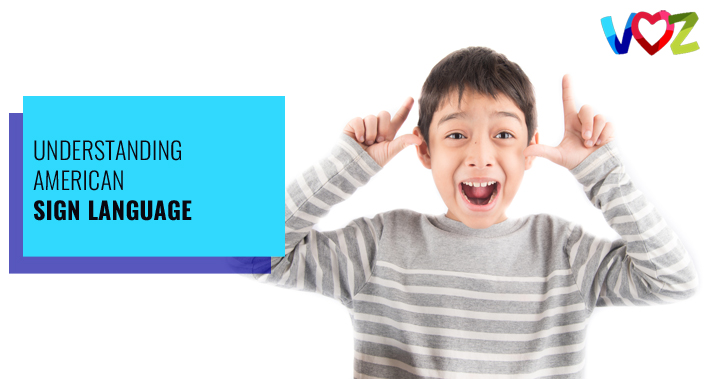
If you or your child have difficulty communicating verbally, learning and using American Sign Language can help free your voice.
American Sign Language, commonly referred to as ASL, is a way of nonverbal communication that uses your hands to form signs.
ASL has become a popular method of communication, and isn’t exclusive to the Deaf community.
As an augmentative and alternative communication method it can be useful for people who have been diagnosed with conditions that limit their verbal speech, such as autism.
Speech therapy can help you develop the skills you need and give you the tools to communicate more effectively.
Here at Voz, a Washington DC speech clinic, we offer speech therapy services for all facets of speech and language related issues.
Let’s take a closer look at what exactly American Sign Language is, where it came from, and how it’s used.
What Is American Sign Language?
American Sign Language, or ASL, is a way of nonverbal communication that uses your hands to form signs.
Aside from your hands, ASL also uses facial expressions and body movements to express emotions in interpersonal communication.
Facial expressions in ASL convey rhythm and tone, which is otherwise absent if you’re just using hand signs.
American Sign Language also doesn’t mirror spoken English.
It is its own unique language.
It has its own vocabulary and grammar that’s different from other languages.
Facial movements and hand motions factor into the type of grammar used and the message you’re trying to convey.
Some ASL speakers also mouth the words that they sign for better understanding or intonation.
Keep in mind that ASL isn’t the only sign language to exist.
There are many forms of sign language, all with unique differences as they developed independently in different communities.
Who Created American Sign Language?
Sign language in general is difficult to trace back to a specific point of origin.
The idea and act of using our hands to communicate has always been a part of our growth before learning to speak verbally.
As babies and kids, we use our hands to point and grab toward what we want or shake our heads in disapproval.
Our early ancestors also communicated using hand and facial gestures before any formal languages were created.
There were several attempts in history to create a standard sign language.
It was Charles Michel De L’Epee, a French priest, who made progress when he created a free public school for the Deaf in Paris.
He translated the French alphabet into a sign language that included letters, symbolic gestures, ideas, and concepts.
In the 1800’s, Thomas Hopkins Gallaudet, along with Laurent Clerc, a Deaf sign language instructor, developed ASL.
They were able to establish a school for the Deaf and make ASL a unique sign language to the United States.
ASL was created from a combination of French Sign Language, signs from a small commune in Martha’s vineyard, and possibly from the signing system of the Great Plains Native Americans.
Is American Sign Language The Only Sign Language?
American Sign Language isn’t the only sign language that exists or is used around the world.
ASL itself is rooted in an older version of French Sign Language, as we talked about just above.
There are many different sign languages that exist, and they are all unique from one another to a certain degree.
Like spoken languages, sign languages are different because they were created within different communities across the globe.
Furthermore, sign languages constantly evolve and develop and have been adopted throughout various parts of the world.
England has its own sign language, BSL, and so does Australia – Auslan.
Sign languages are rich, diverse, and quite varied.
Is ASL An Actual Language If It’s Not Spoken?
ASL may not be a nonverbal language, but it’s still considered to be an independent legitimate language.
This is because it was initially developed specifically for Deaf people and has its own unique vocabulary and grammar.
At times ASL signs don’t perfectly translate to English.
Sign language has specific grammatical rules that go beyond just what symbols and gestures your hands make.
Things like your eye and eyebrow positions and hand and body motions all play a role in what you’re communicating.
Some people also use Pidgin Signed English, or PSE.
This is different from ASL and not its own language.
PSE is more common with people who lose their hearing later in life, and is a combination of ASL and spoken English.

Can You Teach American Sign Language To Babies?
As babies we naturally point and grab things to express what we want or shake our heads to express what we don’t want.
In this sense we all use a form of sign language before we develop our ability to communicate verbally.
Similar to spoken language, babies are able to pick up and develop sign language skills growing up in a signing home.
They will begin to adopt signing through natural interactions in their daily lives.
Babies will start signing with simplified signs that may appear cute or humorous.
These initial signs and skills will develop over time to more complex signing and include more advanced grammar.
Can Kids Learn Spoken Language And ASL At The Same Time?
Sign language isn’t exclusive to Deaf people as a way of communicating.
Even children that are able to hear can learn sign language.
This is becoming popular especially with families that have special needs children who may experience speech delays.
Some common conditions that often have accompanied speech delays include Down syndrome, cerebral palsy, and autism spectrum disorder.
Some parents may be cautious of teaching their child sign language fearing that it may delay their verbal speech.
Learning sign language doesn’t affect a child’s speech development, and in fact it may actually increase their verbal skills.
RELATED: How Do Babies Learn Two Languages At The Same Time?
Being able to sign and use gestures before being able to communicate verbally can help children with speech delays talk to their parents and siblings.
It can help create stronger familial bonds as well as help children feel more independent and less frustrated.
Sign language doesn’t have an adverse effect on language development in children.
It actually may promote cognitive benefits through the ability to communicate through diverse methods and perspectives.
Book Your Appointment With Voz Speech Therapy Today
If you or your child have a condition that limits or delays your speech, sign language is an alternative that can help you communicate and socialize more effectively.
We know the difficulties of having speech delays or restrictions on your ability to speak or communicate, and we want to help.
At Voz Speech Therapy we will work with you or your child to give your voice freedom and give you more independence.
Book your appointment with Voz Speech Therapy today.
1331 H St NW Ste 200,
Washington, DC 20005
(202) 734-4884
- https://g.page/vozspeechtherapy
Voz Speech Therapy is a pediatric bilingual speech therapy clinic in Washington, DC that provides individualized services based on the specific needs of your or your child. Therapy sessions are provided in English or Spanish, depending on your child’s native language. Voz Speech Therapy es una clínica pediátrica bilingüe de terapia del habla en Washington, DC que brinda servicios individualizados según las necesidades específicas de usted o su hijo. Las sesiones de terapia se brindan en inglés o español, según el idioma nativo de su hijo.